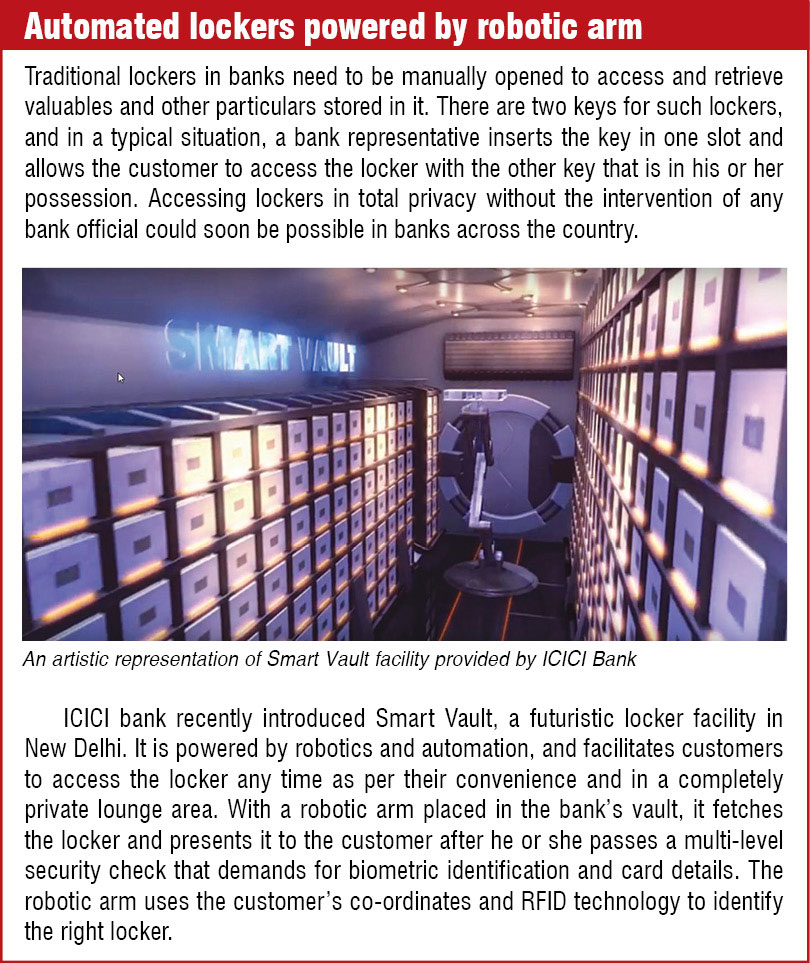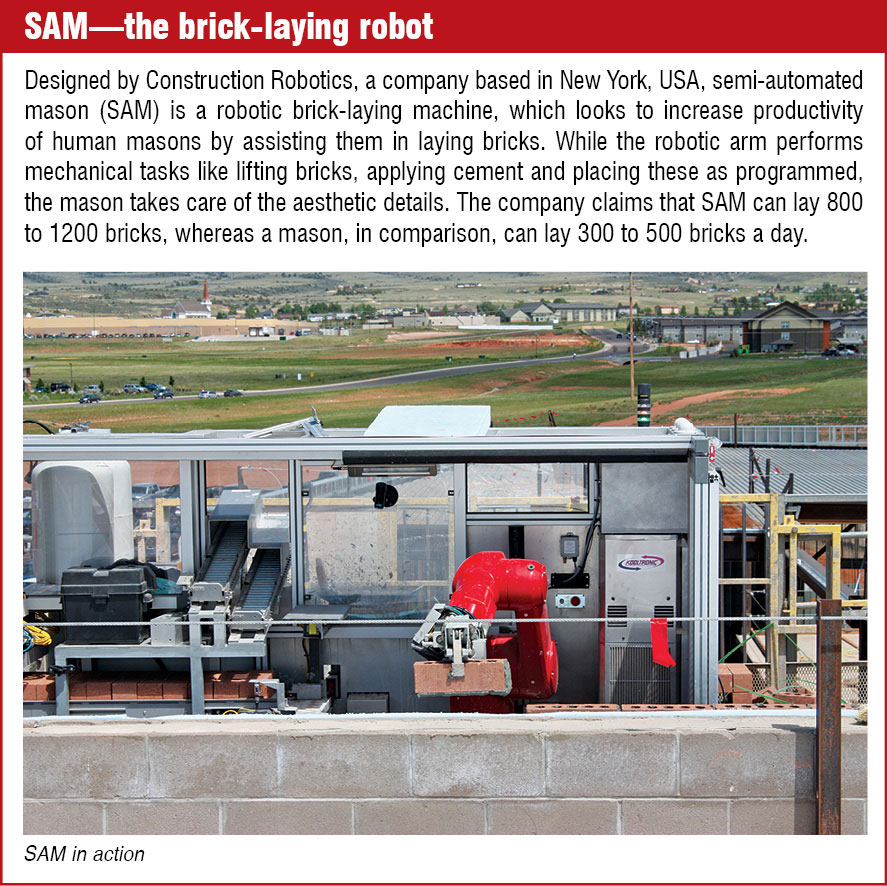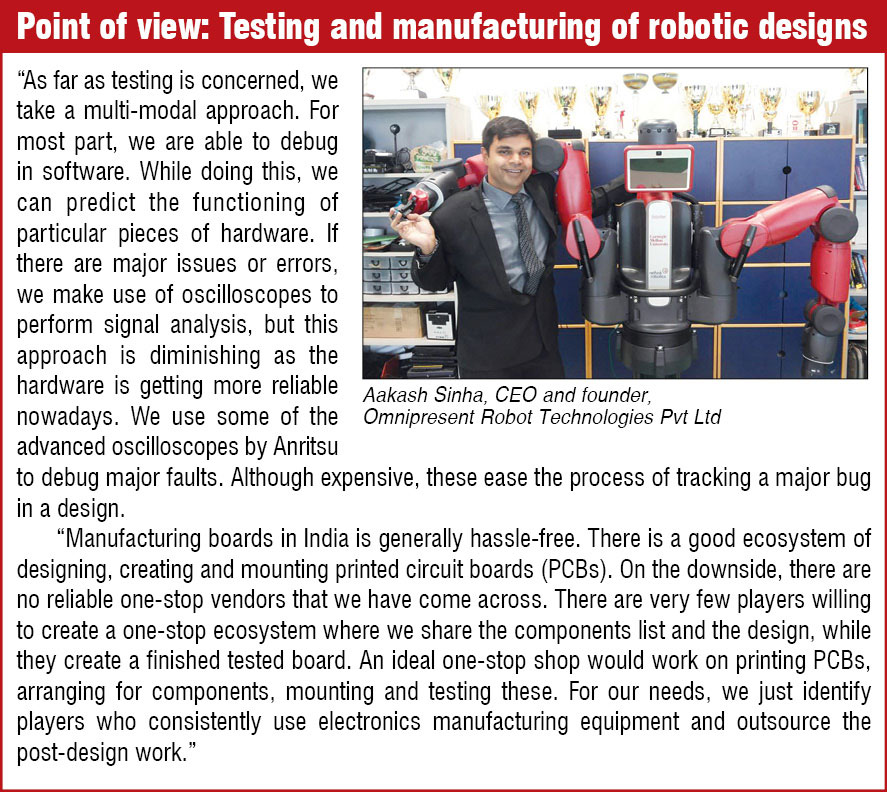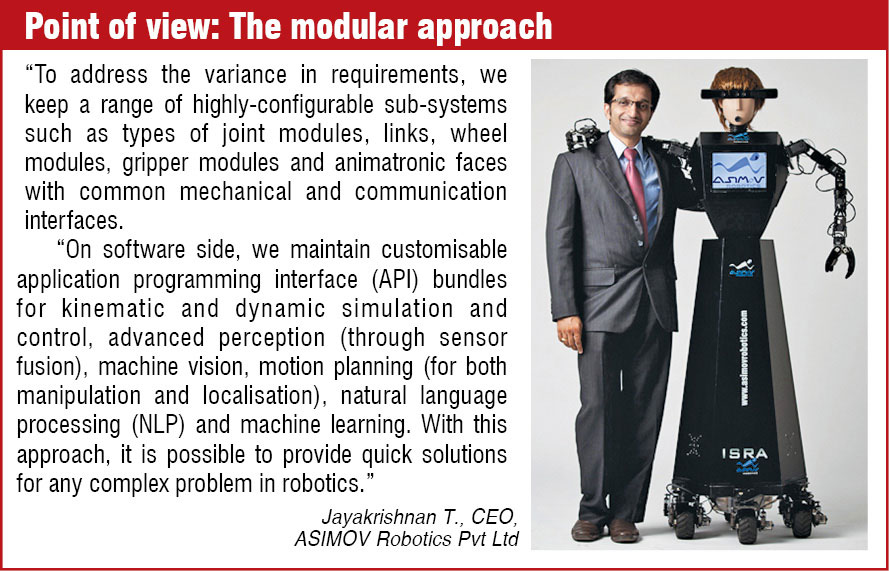Today aerial, land and aquatic forms of robots are used for diverse applications in medical, military, industrial, space, entertainment and domestic market sectors. All these robots might look very different from each other but internally these all follow the same key paradigm that defines a robot—Sense, Think and Act. Robots must be able to sense the world, process the information and perform necessary actions. “The Sense, Think and Act paradigm is followed by robots in any situation, be it cleaning rivers, bomb disposal or flying. The only difference is in the implementation of the paradigm,” says Aakash Sinha, CEO and founder, Omnipresent Robot Technologies Pvt Ltd.
In this article, we highlight some of the recently-launched smartmachines across the world that are implementing the Sense, Think and Act paradigm in different ways to automate tasks, while focusing on the ecosystem for robotics in India.

Components on the rise for robotics applications
The sense, think and act tasks performed by a robot need their own set of components. Below are some components that are increasingly being embedded in intelligent machines today.
To sense. A lot of sensors are available off-the-shelf today. For example, SRS series ultrasonic sensors are very popular for building small robots, informs Sinha. Radar and lidar sensors are also widely used for various applications. Sinha adds, “Lidar sensors made by SICK Group or Velodyne are widely used, the latter being expensive but very good for applications like terrain mapping.”
To think. There is a plethora of single-board computers as well as auto pilots available in the market. Pixhawk auto pilot is popularly used in a lot of robotic vehicles, including the ones that operate on land, water and air. Similarly, there are many single-board computers readily available.
For building basic robots, one can start off with Raspberry Pi 2, Arduino or BeagleBone boards, informs Sinha. He says, “We have used Radxa Rock for some of our designs. It is quite powerful as it comes equipped with a quad-core processor, 2GHz of random access memory (RAM) and NAND flash built into it, and is very good for advanced robots.”
To act. Servomotors are a key element in robotics and the industrial automation space. Motors are made as light in weight as possible but meet the heavyweight expectations from the industry today. There are some very promising introductions in the brushless DC motors segment lately. These motors are very useful for building robots, as these do not wear out easily. Some of the recently-released components are FAULHABER 3274 BP4 series DC servomotors, FAULHABER 2057XXXXBHS series brushless DC servo motors, Nanotec Electronic’s DB80, Maxon Motor’s EC-4pole 30 and Global Electric Motor Solutions’ NEMA hybrid stepper motors, to name a few.

Onboard gyroscopes, accelero-meters, magnetometers, temperature and current sensors are some other components required to monitor the health and location of the robot, informs Sinha. At times, all these components come integrated in a board. “For instance, Pixhawk auto pilot already has inbuilt gyroscope, accelerometer and magnetometer, while the global positioning system (GPS), temperature and current sensors can be additionally incorporated,” says Sinha. “Off-the-shelf components can be bought with a lot of ease today than a few years ago,” he adds.
There are certain key aspects that one has to consider while developing highly-interactive robots. Cognitive intelligence, omni-directional mobility, gravity-compensated manipulation and back drivability are some of these, informs Jayakrishnan T., CEO, ASIMOV Robotics Pvt Ltd. He says, “The new concept of flexible manufacturing is a typical example. Hence, most of our robot platforms are either compatible or come with these capabilities integrated into them.”
Availability of components is a challenge as many components like sensors and motors from reliable vendors are not easily available in India. “Steadily, we are witnessing a network of distributors emerging in India who import these components and make these available for robot makers. Some examples of such distributors are Robokits and RcBazaar,” informs Sinha.


High degree of standardisation required
Standards is one aspect lacking in the robotics industry, feel experts. There have been some successful attempts at standardisation. For instance, Robot Operating System (ROS), an open source framework, has a certain set of libraries and tools that are flexible for writing software for robots. Robots supporting ROS have significantly increased over the years. “As this field is so nascent, standards are still not up in place. There are several other architectures being followed, but there does not seem to be any universally agreed upon and followed standard in place,” says Sinha. This often results in robots being built from scratch for different applications. Therefore there is a lot of scope for standardisation, and ROS is one of the leading examples.
From a design perspective too, standardisation is yet to take place. The reason for no standardisation is partly varying customer requirements. Sinha says, “In some cases, there might be a need for a very high degree of standardisation, like when building a system for space missions. We are jointly working with Indian Space Research Organisation (ISRO) on a module for Chandrayaan-2 mission for the moon-landing part.”
Standardisation in hardware and software must go hand in hand. In the electronics industry, a development board is usually compatible and works on various standard operating systems (OSes) such as Linux or Windows. There is a requirement for boards to be compatible with standardised robotics OSes. Sinha says, “Currently most of the boards like Raspberry Pi 2 and Arduino are crafted for the development of electronics and Internet of Things (IoT) designs. We need boards designed purely to make robots.” He adds, “An ideal robotics board must support all the common sensors and motors, typically with plug-n-play attachments.” With standardised boards and OSes for robots, creating these will become exponentially easier.
Long way to go for robots to mimic humans, human-machine cooperation
Scientists and researchers have developed robots over the years that mimic humans. Emotional Robot with Intelligent Network (ERWIN) was created by scientists from the UK. This robot could display five distinct emotions.
Another group of researchers from Massachusetts Institute of Technology, USA, has developed a robot named HERMES that can mimic moves made by a person to whom the feedback-balance interface in connected. Robots are evolving.

Due to demographics and lack of interest in blue-collar jobs, there will be a huge resource deficit in the personal and professional services sector in the near future, believes Jayakrishnan. He says, “A massive moment is silently taking place globally among the leading technology organisations to address this issue through robotics.” He adds, “A collaborative work force is the next big thing where humans and robots co-exist and co-operate in all possible ways.”
Better standardisation will encourage innovation and competition, thereby enabling the creation of more effective designs. Sinha says, “We have the necessary hardware to process huge amounts of data but we are unable to make robots think like human beings. The question I often ask is: How can we make robots think and learn like humans?” We are already seeing some light in the form of deep learning implemented over ten layers of artificial neural networks, but still have a long way to go before robots come closer to human learning capabilities, according to Sinha.










